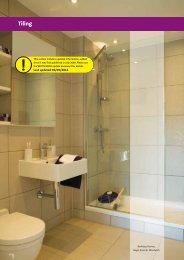SITE BOOK - Plaster systems - British Gypsum
SITE BOOK - Plaster systems - British Gypsum
SITE BOOK - Plaster systems - British Gypsum
Create successful ePaper yourself
Turn your PDF publications into a flip-book with our unique Google optimized e-Paper software.
www.british-gypsum.com<strong>Plaster</strong> <strong>systems</strong>9– <strong>Plaster</strong> is applied when dry, allowing flexible timing ofapplication.– <strong>Plaster</strong> can be applied at normal thickness (i.e. up to13mm). Maximum 10mm on soffits.– No dilution, so no confusion on site.– Green coloured for ease of identification in application.Thistle GypPrime bonding agent is specially formulated forthe pre-treatment of very high suction backgrounds. It is theonly product recommended for use with Thistle plasters. Itcan be diluted as required giving total flexibility, for differentlevels of suction control, and is yellow coloured for ease ofidentification.ThistleBond-it and Thistle GypPrime should be appliedstrictly according to the user instructions. Care should betaken not to exceed the recommended plaster thickness,otherwise bond failure may result. Where a greater thicknessof plasterwork is required, due to an uneven background forexample, an alternative carrier for the plaster should bespecified, such as metal lath.Sand / cement undercoatsThis method of plastering is now largely superseded bygypsum plastering. Obtaining the correct grade of sand andallowing sufficient time for drying shrinkage of the sand /cement are essential to reduce the risk of subsequentpossible defects.If sand / cement or sand / lime undercoats are used, thefollowing points should be considered:– Sand and cement will shrink on drying.– Retarded ready-mixed sand / cement renders may delayshrinkage and may be incompatible with gypsum finishplasters.– If finish coat plaster is applied too early, differentialmovement resulting from sand / cement shrinkage maycause cracking in the finish coat. This may not be detectedwhen using retarded mortars for extended periods of time.– Shelling of finish coat plaster from all types of sand /cement backgrounds can occur due to incompleteshrinkage, over-sanded undercoat and / or lack ofmechanical key.– The key provided to sand / cement by scratching needs tobe much better than that to a gypsum undercoat.– Suction should be adjusted by sprinkling with clean waterjust prior to plastering.418





